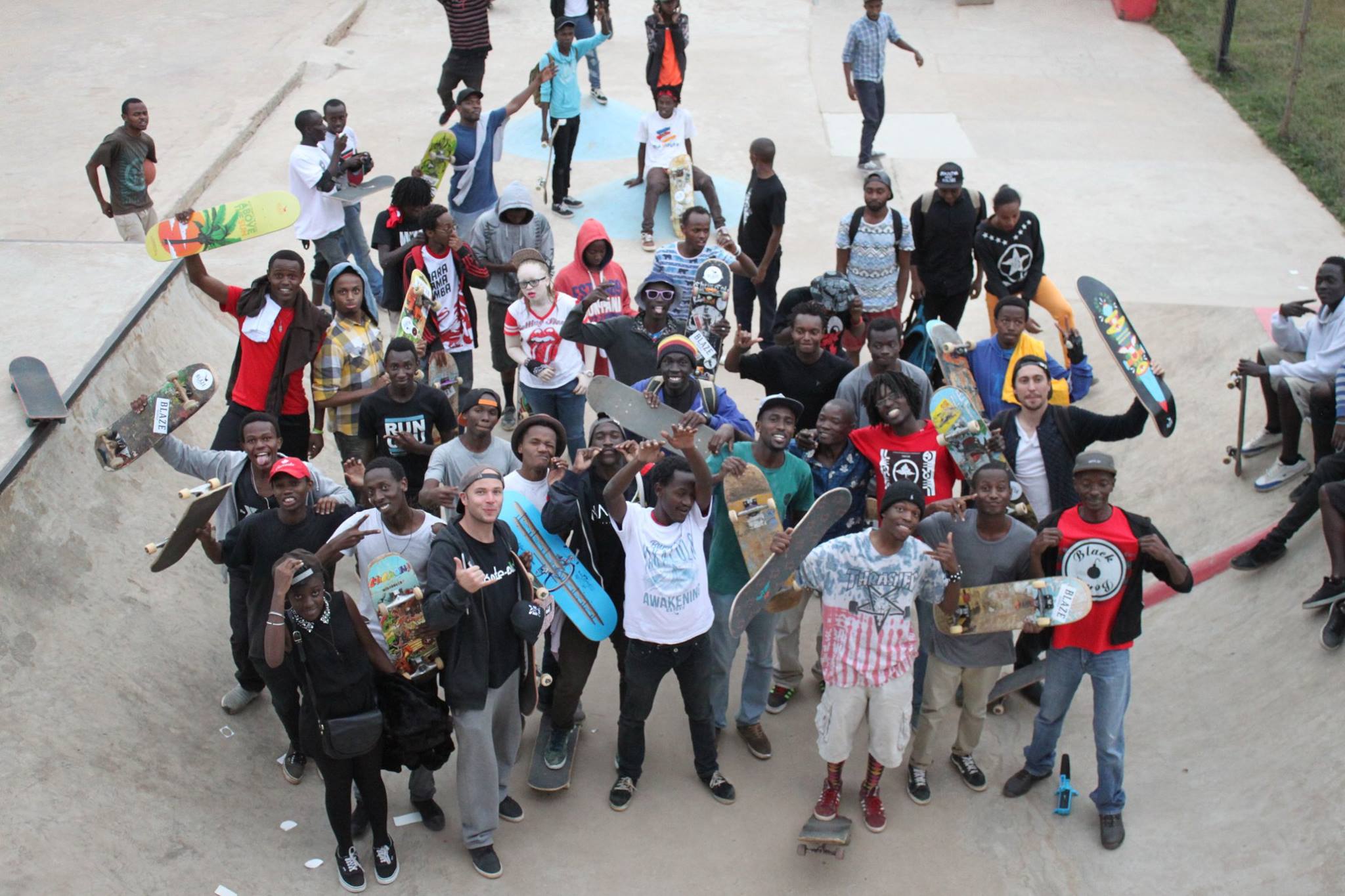More than anyone, and everywhere young people need to feel like they are recognized and appreciated (by their communities): In too many places skateboarders get the wrong message and public image from local authorities who limit or outlaw skateboarding and ignore its inherent (health- and selfempowerment) benefits for the skateboarders and communities around skateparks.
Every open skatepark and public place supports hundreds of kids that might otherwise have nowhere (safe) to go. Furthermore the diversity of a skate park community can provide a social #grassroots supportnetwork where school, family and „traditional sports“ clubs may not be adequate / connecting today with the younger generation(s).
Young people need things to do and places where they are free to be themselves within our cities and suburbs — this needs to include not only facilities and public areas that cater to more traditional and formal sport, but also those that provide for skateboarding as a popular and healthy form of recreational and social activity. While skateparks with high visibility and ample community interaction are healthier environments, skateparks in challenging locations can often serve to activate an otherwise underutilized space.
Skateboarding is a global movement in 2019
Skateboarding started off in west-coast America around the 1960s. At times (seasons), where no waves were possible to be surfed, pioneers constructed rollerskates under (surf-) boards to cruise the beach promenades and streets. Shortly after this idea turned into a movement, which inspired Thrill-seekers to drop in on empty pools and sidewalks. While several trends swept parts of Europe, North and South America and Asia about four decades ago, it took longer to get to places like East-Africa. Over centuries later, it is proven, that Skateparks build and sustain healthy communities: As a gathering place for dedicated youth, the skatepark provides the forum for young and old, beginning and skilled, to meet and share experiences and advice about skateboarding and life in general. For many skateboarding youth, the skatepark becomes a home-away-from-home, where the younger ones learn (life) lessons from the older ones, reaching from basic injury tips, over becoming more aware and responsible for their own health & life and additionally gain confidence to test their limits through the brave act to continuously push their individual physical and menthal borders through the of skateboarding together in a safe environment.
Skateboarding is NOT what most people think
While public health institutions are engaged in unprecedented efforts to counter the sedentary lifestyles of youth, the promotion of lifestyle sports and active leisure practices, such as skateboarding, is tempered by the potential risks of injuries. Its findings indicate that few serious injuries occurred in these skateparks and that these spaces do not correspond to the image depicted of skateboarding in previous research. From this and our experience, we want to promote that skateparks should be conceived as a valuable health‐resource for communities because they provide various social, psychological and physical resources that encourage a safe and active lifestyle for all aspects concerning life.
Skateboarding does not have to be noisy
Some people also decry the noise associated with skateboarding. A concrete skatepark should be no louder than most athletic activities. When skateboards are rolling down a rough sidewalk they are clearly heard and it may seem incongruent with other things happening on the street. But at a skatepark, where the concrete is smooth, skateboards are relatively quiet and the sounds coming from a skatepark are similar to sounds one might hear at a ball field or playground.
Skateboarding encourages Self-Empowerment & (Social) Skills Development
Because skateboarding can be practiced alone also as a group activity. By experiencing skateboarding together, we are able to build strong interpersonal relationships. Along the way in our journeys to different places and skateparks, we will meet like-minded individuals who share the same passion (and often also the same values) as us. More than a bond in just the training, we develop deep emotional connections with other practitioners that we call friends and homies. In spite of all the associated dangers, skateboarding sure does wonders for the body and mind in the long run. Skaters need to be focused and alert, particularly in a skatepark setting, to maintain their balance and to perform the maneuvers they do.
At skateparks, older skaters tend to look after younger skaters. They offer tips, help them out when they fall, and will rise to the occasion when they have the opportunity to set a positive example or mentor a younger skater. A skatepark is a place where skaters get together and enjoy the space, the camaraderie, and the physical thrill of riding. An outdoor, open, highly visible location–as most skateparks are–is not the place to bully kids, use drugs, or be a nuisance. Skaters are there for a reason, and are generally very good at policing each other about behavior that interferes with their enjoying the park. Skateparks, where the skaters have trouble with non-skating drug users and delinquents showing up, are typically located in secluded areas, where casual supervision is infrequent or doesn’t exist. It’s an unfortunate situation, but it’s one that the skaters suffer from, rather than create themselves. It is important that the skatepark is positioned somewhere in the community where there is ample pedestrian traffic. This prevents people from preying on the captive skatepark audience. A well-built and properly sited skatepark that reflects the needs of the local skaters is a hive of creative, physical activity, a place where kids and adults who enjoy skateboarding come together and are focused on their sport in an inherently positive environment.
Public Skateparks and open Skatespots encourage positive (social) Change (in their communities)
Skateboarding is a sport, an art form, a lifestyle, and a culture which also creates friendships between people from different (social) backgrounds. With more than 100 million (estimated) active skaters, skateboarding is gradually becoming one of the most popular hobbies shared by people around the globe. Contrary to what most parents think, apart from funky clothes, shoes, attitude, and gravity-defying tricks, skateboarding does offer some amazing benefits for the mind and body. The best part about this sport is the convenience of practicing it anywhere; it can be performed indoors or outdoors, and in large spaces or small confined areas. Skateboarding brings the people together from different backgrounds and economic statuses.”
Cities & Communities should provide open spaces like skateparks, because
- Skateparks & public Places reduce illicit behaviour: The myth surrounding skateparks is that they are a breeding ground for crime and other illicit activities. While there will be an occasional “bad seed”, providing designated spaces for positive activities is the best way to curb unlawful behavior among youth. When youth having nothing to do or nowhere to go — that is when they cause trouble.
- Skateparks & public Places provide a safe environment: The majority of skateboarding injuries happen outside skateparks. The most common injuries are falls due to surface irregularities and collisions with motor vehicles or pedestrians. Skateboarding is going to happen whether skateparks exist or not, so the best way to keep youth safe is to provide them access to safe, designated spaces to pursue their activity.
- Skateparks & Public Places draw skateboarders away from less appropriate areas: Without a skate park, people will continue to skate wherever there is compelling terrain. With the creation of a skate park we are able to create activity where we desire it to be, and move it away from those places where we don’t. Reclaiming public spaces help people to feel like they are part of a caring and secure community. The busier the place, the more appealing for the youth and the more ‘included’ and valued people feel. An important psychosocial benefit of creating a skate park is that it allows community members to ‘feel safe again’.
- Skateboarding & other creative outdoor activities have significant physical health benefits: Arguably the most important reason for participating in action sports is the fact that it keeps you healthy and physically fit. Finding an activity that gets kids off the couch and keeps them in shape is vital for the youth of this nation, especially in this time of a national health crisis.
- Skateboarding & other creative outdoor activities have significant menthal health benefits: Skateboarding is a unique activity because it combines extreme physical exertion with precise muscle coordination and balance. The complexity of performing tricks on a skateboard improves brain function at a fundamental level and stimulates new cell growth in the brain.
Skateboarding teaches important lessons & longterm skills (for life)
Skateboarding starts with more failures before eventually making managing something basic or even doing a basic trick. Then improvements are made where before you didn’t even think this could be even possible. It’s not a shame to fail, it’s even a bigger mistake to not even try. I believe, that in the first place, skateboarding is teaching us longterm skills for life like responsibility together with “self-improvement” and problem-solving skills, which are important pillars for the foundation to be able to empower ourselves. Skateboarding is much more than a sport, ist a source for inspiration, a tool for self-empowerment teaching us „lessons of life on a wooden toy”:
- Skateboarding teaches Commitment: Similar to martial arts, skateboarding skills and fundamentals must be learned and mastered over time with practice and patience, (unlike the instant gratification provided by television and video games).
- Skateboarding teaches Responsibility: Skateboarding provides a perfect opportunity for a young person to take calculated risks in a controlled environment, with very real and immediate consequences if maneuvers are not executed properly.
- Skateboarding encourages Bravery: This is another amazing skateboarding benefit that not many sports offer. The biggest fear while skateboarding is losing control while doing a stunt. Hence every stunt requires countless hours of practice so that the skateboarder can perform even the most complex stunts with a clear and focused mind. This ability of not giving up, and having a calm and focused mind can prove extremely beneficial in real life (and emergency scenarios).
- Skateboarding encourages Confidence: Through practicing tricks for many times and eventually making it after some time and dedication — you will feel there is nothing hard for you, and you can do & try anything (in life).
- Skateboarding encourages Social Skills And Friends: Skateboarding is a social sport, indeed. It is very super fun for a bunch of people to do the same thing that all love. And you can get help and advice from other people about how to skateboard better. And you can learn how to communicate with others, and how to make friends with others. For introverted children, skateboarding is a great helpful social activity to help them go out and make friendships
- Skateboarding helps with Stress Relief: Any physical activity is considered to be good for relieving stress. Skateboarding can help you take your mind off things. Alternatively, it can also help you think clearly about things. Skateboarding seems to bring things into perspective and allows you to feel as though you’re more in control of other aspects of your life.
- Skateboarding encourages Overall Health: As with all forms of physical exercise, skateboarding can reduce or eliminate your risk for many health problems, such as high blood pressure, diabetes and obesity
- Skateboarding improves Coordination and Balance: Skateboarding involves a lot of coordination between your eyes, legs, feet and arms. The more you skate, the better you’ll get at this. Precision and coordination are used throughout your life, whether you skate or not. When you improve these traits, you better your ability to do all sorts of different things from driving to climbing to multi-tasking.
- Skateboarding teaches Determination: Bruises and bumps. Scrapes and scars. Aches and pains. They’re all a part of skateboarding. And since we love skateboarding so much, we’re willing to take the abuse. The fun and excitement of skating is far greater than the pain involved. Most small injuries go away. You forget about them. But you’ll never forget your first kickflip, your first drop-in, or your first handrail. So we roll with the punches. And those punches become easier to deal with each and every time. We fall. We get up. We try it again with even more determination.
- Skateboarding encourages to get rid Of bad habits: Nowadays many people have such bad habits of staying indoors for a whole day, keep playing smartphones or video games, or more. However, when you pick up your skateboard, such things will not bother you anymore.
Skateboarding and public Skateparks should be supported, because of the pro-social & community benefits — highlighting the value of open Spaces in fostering the development of young peoples’ social skills, self-esteem, cooperation and respect for self and others.
A successful and inclusive city and/or community supports public spaces that encourage interaction, spaces that enable them to celebrate and share common interests. The growing culture of skateboarding has made a huge impact on communities and successfull introduction of Skateparks shows that it is used by people from all walks of life.These people may not know each other socially outside of skateboarding but at the skate park they have the opportunity to become friends and form bonds that cross economic, geographic, and even language barriers. Skateparks are a win-win for cities and (their) communities: Skateparks promote an active lifestyle, no matter the age. Well-designed skateparks can even provide security & economic benefits. Providing a skatepark or public place will allow citizens to thrive in a positive environment dedicated together with economic benefits for their communities.


